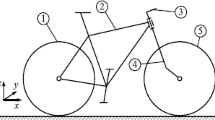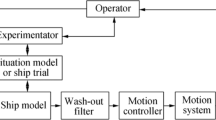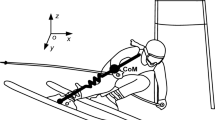Abstract
Bobsleigh is a winter sport in which teams make timed runs down narrow, twisting, banked, iced tracks in gravity-powered sleds. To win the race, it is of great importance to have a sled that is optimized from both the sliding and the aerodynamic point of view. However, also typical vehicle parameters, such as the weight distribution and the inclination of the steering axis, play an important role. In fact, being the friction coefficient between skates and ice very small (approx. 0.04), a change in the weight acting on the front skates may significantly modify the steering feedback of the driver thus highlighting his/her driving ability. Better trajectories imply less correction on the steering axis, and thus better performances. The inclination of the steering axis, instead, generates a torque similar to the self-aligning torque produced by road vehicle tires thus stabilizing the front skates and requiring less control actions to the sled driver.
Up to now, bobsleigh design has been carried out mainly on the basis of the feedback of athletes. The drawback of this approach is that it leads to small modifications in the bobsleigh’s design and it does not allow to objectively identify the influence of the applied modifications/innovative solutions on the bobsleigh’s overall performance.
To be able to quantify the influence of certain design changes on the performance of bobsleighs, it was decided to set up a multi-body model of a two-man sled. To validate the numerical model, an experimental campaign with an instrumented bobsleigh was carried out at Cesana Pariol Olympic track. During the tests, the bobsleigh was instrumented with two inertial gyroscopic platforms to measure the dynamics of the two frames constituting the bobsleigh body, sixteen strain gauge channels to measure the ice–skates contact forces, one optical sensor to measure the bobsleigh speed, and one potentiometer to measure the steer angle imposed by the driver. Numerical results have shown a good agreement with the experimental data.
Similar content being viewed by others
References
Hubbard, M., Kallay, M., Joy, K., Reus, J., Rowhani, P.: Simulation of vehicle and track performance in the bobsleigh. In: Proceedings of the 3rd ASME/ASCE Mechanics Symposium, San Diego, CA, USA, July 1989
Hubbard, M., Kallay, M., Rowhani, P.: Three-dimensional bobsleigh turning dynamics. J. Appl. Biomech. 5(2), 222–237 (1989)
Günther, M., Kielau, G., Maisser, P.: Simulation von Fahrten gesteuerter Bobschlitten. J. Appl. Math. Mech. 74(9), 434–435 (1994) [in German]
Brender, M.Y.: A bobsleigh dynamic model and its experimental validation. Master’s. Thesis, University of California, Davis, CA, USA (1995)
Dabnichki, P., Baca, A.: Computers in Sport. WIT Press, Southampton (2008)
Gran, R.J.: Creating Simulations. Numerical Computing with Simulink, vol. 1. Society of Industrial and Applied Mathematics (SIAM), Philadelphia (2007)
The MathWorks: MatLab Online Documentation. http://www.mathworks.com
Kielau, G., Maisser, P.: Nonholonomic multibody dynamics. Multibody Syst. Dyn. 9(3), 213–236 (2003)
Hainzlmaier, C., Mack, C., Wolf, S., Wintermantel, E.: Computational mechanics in bobsleigh: Finite element model of runner and ice. In: Proceedings of the 5th International Conference on the Engineering of Sport, University of California, Davis, CA, USA, 13–16 September 2004
Itagaki, K., Lemieux, G.E., Huber, N.P.: Preliminary study of friction between ice and sled runners. J. Phys. Colloq. 48(C1), 297–301 (1987)
Itagaki, K., Huber, N.P., Lemieux, G.E.: Dynamic friction of a metal runner on ice. Cold Regions Research and Engineering Lab, Report 89-14, Hanover, NH (1989)
Petrenko, V.F., Whitworth, R.W.: Physics of Ice. Oxford University Press, New York (1999)
Kozlov, I.I., Shugai, A.A.: Experimental study of high-speed friction on ice. J. Fluid Dyn. 26(1), 145–147 (2005)
Braghin, F., Cheli, F., Melzi, S., Sabbioni, E.: An heuristic skate–ice contact model obtained through finite element simulations. In: Proceedings of the 2nd European Conference on Tribology (ECOTRIB 2009), Pisa, Italy, 7–10 June 2009
Riedel, A., Wurster, U.: IPG-driver model for real life vehicle dynamics simulation. In: Proceedings of LMS Conference Europe, Stuttgart, Germany (2007)
Braghin, F., Cheli, F., Melzi, S., Sabbioni, E.: Race driver model. Comput. Struct. 86(13–14), 1503–1516 (2008)
Sharp, R.S., Casanova, D., Symonds, P.: A mathematical model for driver steering control with design, turning and performance results. Veh. Syst. Dyn. 33(5), 289–326 (2000)
Author information
Authors and Affiliations
Corresponding author
Rights and permissions
About this article
Cite this article
Braghin, F., Cheli, F., Donzelli, M. et al. Multi-body model of a bobsleigh: comparison with experimental data. Multibody Syst Dyn 25, 185–201 (2011). https://doi.org/10.1007/s11044-010-9218-7
Received:
Accepted:
Published:
Issue Date:
DOI: https://doi.org/10.1007/s11044-010-9218-7




